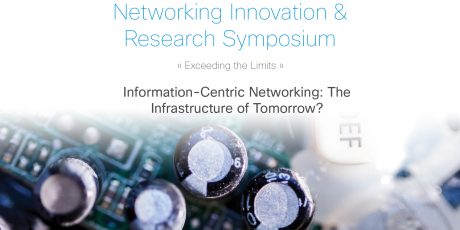
[Symposium 2017 – #3] Information-Centric Networking: The Infrastructure of Tomorrow ?

Sponsored article – Author: Pierre Guyot, Editor, Usbek & Rica
The symposium “New Generation of Networking Innovation and Research” Cisco – École Polytechnique 2017
Information-Centric Networking (ICN) is a networking infrastructure where the communication model is no longer based on a server, cache, or another network element, but rather on, as its name indicates, information. The information becomes itself the heart of the communication: it is recognized and addressed directly by the network. Schematically, this means that the packets of data are named by a unique identifier, whatever their position in the network; from then on, they can be recovered upon demand by the user.
As was mentioned in an article published in 2009 by Van Jacobson, one of the fathers of the Internet, ICN proposes a fundamental change relative to the present Internet host-centric paradigm: one goes from permanent connectivity to a more dynamic connectivity, adapting itself to the changes of position of the user and the content. Mobility is thus favored in the future “by design,” leaving the way open for new functionalities in mobile connectivity, multicast, and content distribution, but also a simplified communication for the Internet of Things (IoT).
ICN: a potential for the Internet of Things
Several participants insisted precisely on this point in the symposium session dedicated to ICN: the potential of this new paradigm could, in fact, meet a ready-made partner in the Internet of Things.
Matthias Wählisch, manager of a group researching Internet technologies at the Freie Universität of Berlin, leads an initiative to bring together industrial Internet (that is, the Internet of Things in its industrial applications) and ICN. Attracted by the potential for the gathering of data based on the names of their activities, these industrialists are actually looking to build a future composed of devices that can be connected and interconnected. The potential is evident for an actor in specialized industrial monitoring, for example in the detection of gas leaks.
Attacking a completely new problem open to new technologies, these actors are looking for new connections, not through proprietary solutions, but through standard Internet protocols. Consequently, there are massive opportunities for ICN in terms of mobility (since at the heart of the model remains the content, wherever it may be, and not the addressing of it), in terms also of security, but above all of reliability (the data is already in the network and the traffic is predictable), and of simplicity in the management of the network (the only thing that counts is the naming of the data and not its route). Some questions, of course, remain open, such as knowing how, operationally, to have ICN intervene in an inter-domain network. It is thus necessary to continue to develop prototypes, to which the Berlin university of Matthias Wählisch has become committed through projet I3.
The experiments on Named-data Networking (NDN), the name coming from the ICN architecture for the Internet of Things, had in fact began in the 2010’s and we know since 2014, thanks to the work done especially by Matthias Wählisch and Emmanuel Baccelli (another participant in the symposium), that ICN can perhaps work better than the traditional IoT protocols in terms of simplicity, but also of the amount of energy being consumed. It is on this last point, crucial for IoT networking, which is very demanding in available data, that the INRIA researcher Emmanuel Baccelli works with simulations on a dedicated operating system, RIOT, and the IoT-LAB platform. It remains to scale and develop these experiments operationally.
The range of possibilities is in reality quite greater: Andrea Detti of the University of Rome Tor Vergata has leaned, for example, towards the pertinence of ICN for spatio-temporal objects in the NoSQL data bases, which are at the heart of managing information for the Internet of Things and the Big Data of tomorrow. There again, the reasons are the same: there is the possibility of greater simplicity in software development and network management, increased performance thanks to multicast and a cache situated in the network, and security at the level of the data. Result: an OpenGeo-Base platform and a demo, particularly usable for transport and travel companies. The rate of transfer is judged to be low and the model proposed does not work for all types of applications, but the route has been mapped out.
« With the cloud and distributed intelligence that the IoT uses, there is an impulse towards a more and more decentralized network.»
The video interview of Emmanuel Baccelli, Inria researcher:
« The cloud is not enough »
At the center of the challenges is thus the necessity to improve the cache performance of ICN networks. Hermann Hellwagner of Klagenfurt University, who is making public his work presented at the Paris IEEE International Conference on Communications in May 2017, is working on this question. He led a beginning study on feasibility based on monitoring flows that depend on the reasoning of logical declarative programming, a study that has shown itself to be successful on a simple infrastructure problem. It remains, yet again, to generalize this beginning work.
If one observes, more generally now, all the Internet applications to come, one could say that “the cloud is not enough,” as Ionnis Psara, of the London UCL, put forth in a sympathetic diatribe. His work on “Kebapp,” a password sharing model of a mobile application between several users thanks to ICN, had won the prize in 2016 for the best research during the international workshop “Mobility in the Evolving Internet Architecture.” Waiting for 5G and given that the growth in demand for video flow is going to increase the need to go through edge computing functionality, this distributed architecture favoring the processing of data near terminals means that the cloud—which is not available for the user in all mobile situations—does not seem in fact to always be the best option.
Not only ICN, but 5G could also very well take advantage of the software calculation and storage capacity of the devices surrounding us upon network access (smartphones and tablets, Wi-Fi access points, 4G base stations, home gateways, etc.). Which is the most suitable? On the horizon is the development of a platform based on information-centric connectivity for IoT applications. But avec Ionnis Psaras, as well as with Jacques Samain, Cisco PhD for mobile video streaming, or Mayutan Arumathra of the University of Goettingen for multicast, it can be seen, in any case, the advantages of ICN relative to the TCP/IP protocol. A decisive advantage for tomorrow? The consortium dedicated to the rollout of ICN “in the real world” and on a global scale is called, after all, ICN 2020…
Relive the symposium now by looking at our playlist.
Find all the symposium articles on our blog:
- The Future of Infrastructures: Exceeding the Limits
- The Opinion of Mark Townsley, Cisco Engineer and Co-founder of the Paris Innovation and Research Lab
- Artificial Intelligence: its Impact on Networking
- Media Production Makes its Transformation to IP
- IPv6-centric Networking, a Crucial Rollout for Tomorrow










